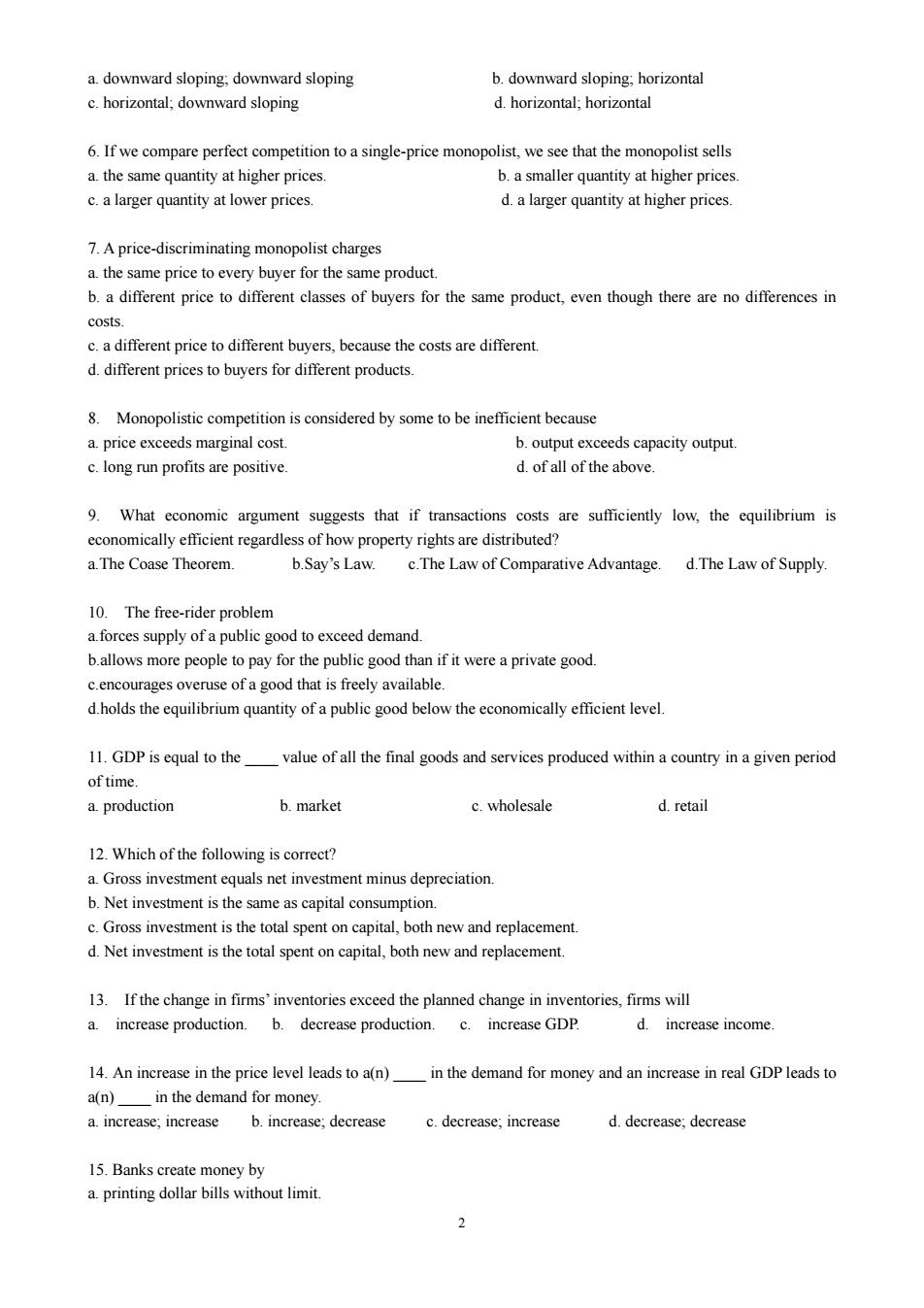正在加载图片...

a.downward sloping:downward sloping b.downward sloping,horizontal c.horizontal,downward sloping d horizontal:horizontal 6.If we compare perfect competition to a single-price monopolist,we see that the monopolist sells a.the same quantity at higher prices. b.a smaller quantity at higher prices c.a larger quantity at lower prices. d.a larger quantity at higher prices 7.Apric-discriminating monopolist charge a the same price toevery buyer for the same product. b.a different price to different classes of buyers for the same product,even though there are no differences in costs. c.a different price to different buvers.because the costs are different. d.different prices to buyers for different products. 8.Monopolistic competition is considered by some to be inefficient because a.price exceeds marginal cost. b.output exceeds capacity output. c.long run profits are positive. d.of all of the above. 9 What economic argument suggests that if transactions costs are sufficiently low,the equilibrium is conmically fc regardess of how property rights are distributed? a.The Coase Theorem. b.Say's Law.c.The Law of Comparative Advantage.d.The Law of Supply. 10.The free-rider problem a forces supply of a public good to exceed demand. good than if it were a private good c.encourages overuse of a good that is freely available. d holds the equilibrium quantity of a public good below the economically efficient level. 11.GDP is equal to the value of all the final goods and services produced within a country in a given period of time. a.production b.market c.wholesale d.retail 12.Which of the following is correct? a.Gross investment equals net investment minus depreciation b.Net investment is the same as capital consumptior Net inestment is the total spent on capital both newnd re the total spent on capital,both new and replacement 13.If the change in firms'inventories exceed the planned change in inventories,firms will a.increase production.b.decrease production.c.increase GDP d.increase income 14.An increase in the price level leads toa(n)in the demand for money and an increase in real GDP leads to a(n)in the demand for money. a.increase;increase b.increase;decrease c.decrease;increase d.decrease;decrease 15 Banks create m2 a. downward sloping; downward sloping b. downward sloping; horizontal c. horizontal; downward sloping d. horizontal; horizontal 6. If we compare perfect competition to a single-price monopolist, we see that the monopolist sells a. the same quantity at higher prices. b. a smaller quantity at higher prices. c. a larger quantity at lower prices. d. a larger quantity at higher prices. 7. A price-discriminating monopolist charges a. the same price to every buyer for the same product. b. a different price to different classes of buyers for the same product, even though there are no differences in costs. c. a different price to different buyers, because the costs are different. d. different prices to buyers for different products. 8. Monopolistic competition is considered by some to be inefficient because a. price exceeds marginal cost. b. output exceeds capacity output. c. long run profits are positive. d. of all of the above. 9. What economic argument suggests that if transactions costs are sufficiently low, the equilibrium is economically efficient regardless of how property rights are distributed? a.The Coase Theorem. b.Say’s Law. c.The Law of Comparative Advantage. d.The Law of Supply. 10. The free-rider problem a.forces supply of a public good to exceed demand. b.allows more people to pay for the public good than if it were a private good. c.encourages overuse of a good that is freely available. d.holds the equilibrium quantity of a public good below the economically efficient level. 11. GDP is equal to the ____ value of all the final goods and services produced within a country in a given period of time. a. production b. market c. wholesale d. retail 12. Which of the following is correct? a. Gross investment equals net investment minus depreciation. b. Net investment is the same as capital consumption. c. Gross investment is the total spent on capital, both new and replacement. d. Net investment is the total spent on capital, both new and replacement. 13. If the change in firms’ inventories exceed the planned change in inventories, firms will a. increase production. b. decrease production. c. increase GDP. d. increase income. 14. An increase in the price level leads to a(n) ____ in the demand for money and an increase in real GDP leads to a(n) ____ in the demand for money. a. increase; increase b. increase; decrease c. decrease; increase d. decrease; decrease 15. Banks create money by a. printing dollar bills without limit